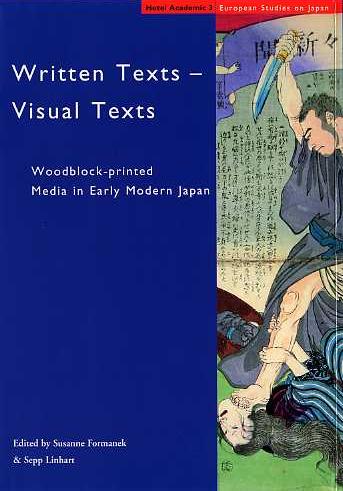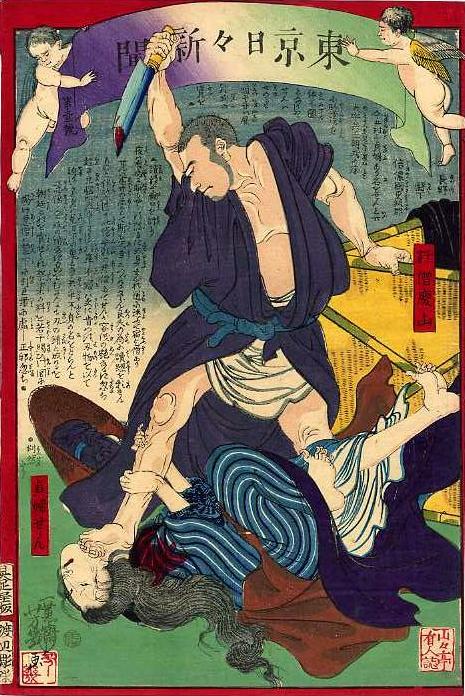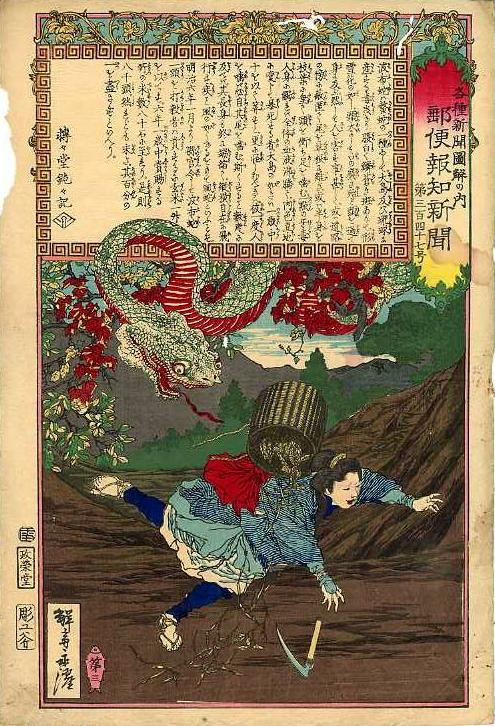Written Texts - Visual Texts
A welcome book with a missing chapter
By William Wetherall
First posted 1 December 2005
Last updated 20 January 2008
A version of this review appeared as "A welcome book with a missing chapter" in Andon, Number 80, June 2006, pages 57-61. The Andon 80 version appeared in conjunction with the cover story, News Nishikie: An arranged marriage that didn't last, by William Wetherall and Mark Schreiber. The version shown here restores some features of the original draft that were changed to accommodate Andon's house style.

A welcome book with a missing chapterBy William Wetherall Formanek, Susanne and Sepp Linhart (editors) This overdue and valuable book serves its stated purpose -- to bring together a variety of technical papers on "the multifarious world of Japanese media from the era of woodblock printing" with a focus on "early modern Japan" -- which the editors define as between 1770 and 1880 (p7). Like most books of its kind it is not without flaws, but its major shortcoming is a missing chapter. IntroductionThe first half of the Introduction, which bears the same title as the book, suggests several reasons why publishers continued to prefer woodblock over moveable-type printing during the Tokugawa period. The most convincing is that artisans developed woodblock technology to the point where it was more flexible and productive for their purposes. Social conditions favoring the proliferation of all manner of woodblock media, such as kawaraban and nishiki-e (as spelled in this book), included some degree of literacy for the "average townspeople and farmers" (p12) and censorship that was "far from strict" (p13) by later Meiji standards. The second half of the introduction is a guide to the contents -- thirteen contributions "loosely assigned" (p16) to three parts. The somewhat arbitrary organization of the book could be viewed as inevitable given its genesis -- a stitching together of articles from a volume first published in German in 1995 with articles more recently written for the book. The editors partly blame the delay in publication on "other projects that interfered with our schedule" (p8). But its long gestation time could have been used to better plan and edit the book, and to check more facts. The "Japanology" of the introduction has a certain mustiness about it. The editors dwell on "the 250 years' peace period between 1600 and 1850" (p9) as though writing a pamphlet for the Ministry of Foreign Affairs. They want to stress that the Edo era "is not a stagnant period, as has often been stated by historians of earlier days, but a period of considerable social and cultural change" (pp9-10). But no one in recent decades has argued that the Edo period was stagnant -- though not a few continue to exaggerate and romanticize its peacefulness. |
Part 1: Modes of Reading Written and Visual Texts
Ekkehard May's "Books and Book Illustrations in Early Modern Japan" is a fairly readable and interesting overview of the development of illustrated stories. His conclusion, though, derails in a popular myth about Chinese characters.
May is fascinated by manga past and present. He offers this opinion as to why comics have become so popular in Japan (p43).
Throughout every one of these [earlier] forms of pictorial literature we find a mixed verbal-visual code of script and pictures, which was perhaps able to develop freely because it springs from and is closely linked to the Japanese system of mixed scripts. In this system, ideograms in their role as an optical code meet with indigenous Japanese syllable script, which, in its turn, is a primarily phonetic code: thus, in many cases, purely phonetic renderings are not sufficient to transmit the complete information contained in a given text.
What May calls "indigenous" script are merely abbreviations of what he terms "ideograms" -- otherwise known as kanji (Chinese characters) -- used phonetically. However, kanji are neither "ideograms" nor "purely optical signals" (p44). Whatever their graphic nature, they originated and still function as representations of syllables or other groups of sounds -- just as kana represent morae (not syllables) and Latin and other scripts represent discrete or clustered sounds.
Some mixed kanji/kana texts have kana alongside the kanji for readers who cannot read kanji. Whether one reads the kanji, or the kana alongside, the result is a flow of sounds that are associated with meanings. In other words, readers of kanji or kanji/kana texts understand their meanings through the language they represent -- which is what makes writing possible. No kanji defines itself in graphic silence.
Yokoyama Toshio's "The Illustrated Household Encyclopedias that Once Civilized Japan" is the best article in the book -- a first-rate overview. "For the last 20 years, I have been visiting private storehouses and archives throughout Japan in search of these virtually forgotten Setsuyōshū" -- grabs with a power not present in other articles.
Susanne Formanek's "The 'Spectacle' of Womanhood: New Types in Texts and Pictures on Pictorial Sugoroku Games of the Late Edo Period" is a bit too long like its title. Two-and-a-half pages of references are followed by seven more pages of notes which could have been integrated into a shorter article.
Franziska Ehmcke's "The Tōkaidō Woodblock Print Series as an Example of Intertextuality in the Fine Arts" picks up speed after one survives the theoretical "tell" at the beginning and reaches the more convincing "show" in the main body. Ehmcke's remarks on "interdisciplinary culture studies" and definitions of "culture" and "intertextuality" amount to claiming that water is wet. "Fine Arts" is another piece of fluff in a title that could simply have been "Tōkaidō Woodblock Print Series".
Part 2: The Provision of Textual Means for Pursuing Specific Interests
Hara Nobuo's "Culinary Culture and its Transmission in the Late Edo Period" is another celebration of straightforward no-nonsense scholarship. One learns that, in the wake of a severe famine in 1782, which witnessed some instances of cannibalism, the Tokugawa government "issued a manual on production of emergency food-substitutes" entitled Waramochi seihōsho or "Instructions for Making Straw-flour Cakes" (p155).
Ann Herring's "The Hidden Heritage: Books, Prints, Printed Toys and Other Publications for Young People in Tokugawa Japan" is a worthy but wordy contribution with long end-notes that should have been integrated into a shorter article with a simple title like "Publications for Children in Tokugawa Japan".
Shirahata Yōzaburō's "The Printing of Illustrated Travelogues in 18th-century Japan", and Martina Schonbein's "Illustrated Kabuki Texts", are two more examples of shorter, sweeter, and more tightly written and edited reports of the kind that would have made the book thinner and more readable without compromising its academic quality.
Part 3: Quenching the Thirst for Information
The final and longest part of the book has five articles. The first and last are by Sepp Linhart, who apparently broke an earlier article into two parts and updated both.
Linhart's "Kawaraban -- Enjoying the News when News was Forbidden" attempts to present the state of research in Japan on kawaraban -- woodblock newsprints -- while introducing a few translations. He writes that the first two (probably genuine) Edo kawaraban "relate to the fall of Ōsaka castle . . . in 1615" (p236).
A section called "Reports of Murders and of Suicides" begins with a paragraph on "the successful vendetta of the 47 rōnin and their subsequent mass-suicide in 1702" (p241). They did not, however, commit suicide. Their vendetta was illegal, and they had two choices -- execute themselves (a privilege allowed samurai) or be executed (as commoners). For good reason, their acts are not described as suicide in Japanese.
Hartmut O. Rotermund's "Illness Illustrated. Socio-historical Dimensions of Late Edo Measles Pictures (Hashika-e)" -- though awkwardly titled -- is a fresh contribution to the large body of literature in English on the history of infectious diseases. Several exhibitions have been mounted in Japan around nishikie and other woodblock publications showing how people dealt with illness and disease in the past.
Stephan Kohn's "Between Fiction and Non-fiction -- Documentary Literature in the Late Edo Period" should have been titled "Descriptions of Disaster in Late Edo Publications" -- for that is what this very credible article is about. It is basically a study of Ansei kenmonshi (ł└ÉŁī®ĢĘÄÅ), a 120-page report of what had been seen and heard about the great earthquake that devastated Edo in Ansei 2 (1855), by Kanagaki Robun (1829-1894), a writer of mostly light fiction and humor.
Reinhard Zollner's "Publishing Ējanaika: Popular Religion as Media Event" is difficult to get excited about because of the way he puts long abstractions ahead of dramatic examples. The article begins like this (p311).
Ējanaika, as I shall use the term in this essay, refers to a temporary set of collective actions and communications among Japanese commoners transcending the framework of everyday life. This phenomenon first appeared in the early summer of 1867 and spread throughout much of Japan, gradually coming to a close by the autumn of 1868; thus it occurred at the same time as the political upheaval that put an end to the feudal order of the Tokugawa regime.
A long page latter we learn that "Ējanaika" (ee ja nai ka) is an Osaka expression which literally means "it's all right" or "anything goes if you feel like doing it" (p312).
Errors of commission and omission
The book concludes with Sepp Linhart's "Shinbun nishiki-e, Nishiki-e shinbun: News and New Sensations in Old Garb at the Beginning of a New Era", which begins with this sentence (p341).
Long famous to ukiyoe collectors all over the world, inexpensive early Meiji-period woodblock prints containing sensational pictures in strident colours of murders, scandals or strange happenings, embellished with substantial explanatory texts and sometimes even with baroque European angels as decorations have, in recent years, at last become an object of serious study for Japanese researchers.
Linhart makes a few observations of his own but mostly digests the fruits of research in Japan. While such an article is highly welcome, it would be more welcome if it didn't compound misinformation in its Japanese sources with numerous mistakes of its own. Most of the errors are mechanical or otherwise trivial but will give the wrong signals to readers not already familiar with its sources -- while a few errors are fatal to the article if not the book.
Many of Linhart's problems begin with the book's failure to treat early newspapers on the same level as other woodblock printed media. Linhart's articles on kawaraban and news nishikie suggest that he is not particularly interested in newspapers.
Newspapers, called "shinbunshi" (ÉVĢĘÄå) in all contemporary media, including nishikie, began as woodblock publications produced by people who traded in "shinbun" (news). Yet everywhere in his article, Linhart mistranslates "shinbun" as "newspaper".
Linhart does not seem to be aware that nishikie claiming to convey "shinbun" (news) were criticized in Tokyo and officially suppressed in Osaka for plagiarizing and distorting stories from newspapers. Even Tsuchiya Reiko, chief architect of the view Linhart subscribes to -- that some if not all news nishikie were important sources of news -- clearly states that they were not newspapers.
Tōkyō nichinichi shinbun (Tokyo daily news), the first Tokyo paper to survive as a major daily, was begun by a full battery of well-known nishikie artisans. Linhart says "none of these newspapers contained any illustrations" (pp343-344) -- yet the very first issue of Tōnichi in 1872 had an illustration right in the middle of its one and only page. And Issue 27 of Yūbin hōchi shinbun (Postal dispatch news) shows the red flag flown by postal steamships -- in color, no less.
The early issues of the earliest newspapers were, after all, printed from carved woodblocks. Linhart's descriptions of news nishikie as "successors" of kawaraban (p20) and as "transitional" forms of illustrated news (p355) do not reflect evolutionary realities. News nishikie were hybrids of souvenir nishikie and news, but their souvenir genes were dominant and they quickly became extinct. Newspapers, however, continued to evolve, and illustrated papers are more like illustrated books than nishikie.
Today's papers are the direct descendants of news companies that began in late Edo and early Meiji woodblock print shops. But this fascinating chapter in the history of "written" and "visual" texts in early modern Japan is missing from this book. A glossary, less cramped index, and color plates would also have made this volume as attractive as others in Hotei's European Studies on Japan series.
Figures
Plates in Linhart's "Shinbun nishiki-e, Nishiki-e shinbun"

